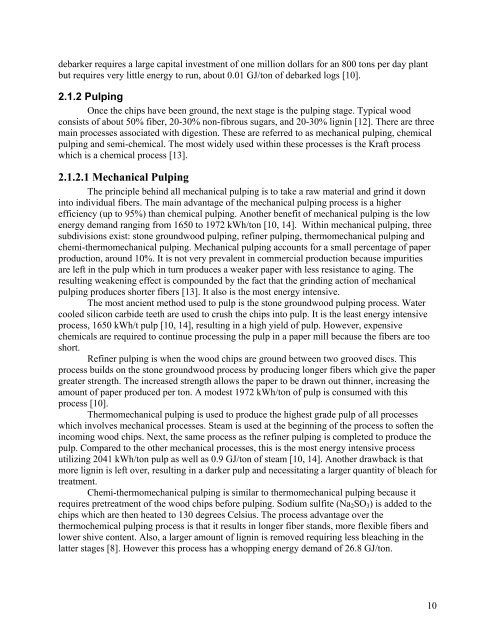Novel Design of an Integrated Pulp Mill Biorefinery for the ...
Novel Design of an Integrated Pulp Mill Biorefinery for the ...
Novel Design of an Integrated Pulp Mill Biorefinery for the ...
Create successful ePaper yourself
Turn your PDF publications into a flip-book with our unique Google optimized e-Paper software.
debarker requires a large capital investment <strong>of</strong> one million dollars <strong>for</strong> <strong>an</strong> 800 tons per day pl<strong>an</strong>t<br />
but requires very little energy to run, about 0.01 GJ/ton <strong>of</strong> debarked logs [10].<br />
2.1.2 <strong>Pulp</strong>ing<br />
Once <strong>the</strong> chips have been ground, <strong>the</strong> next stage is <strong>the</strong> pulping stage. Typical wood<br />
consists <strong>of</strong> about 50% fiber, 20-30% non-fibrous sugars, <strong>an</strong>d 20-30% lignin [12]. There are three<br />
main processes associated with digestion. These are referred to as mech<strong>an</strong>ical pulping, chemical<br />
pulping <strong>an</strong>d semi-chemical. The most widely used within <strong>the</strong>se processes is <strong>the</strong> Kraft process<br />
which is a chemical process [13].<br />
2.1.2.1 Mech<strong>an</strong>ical <strong>Pulp</strong>ing<br />
The principle behind all mech<strong>an</strong>ical pulping is to take a raw material <strong>an</strong>d grind it down<br />
into individual fibers. The main adv<strong>an</strong>tage <strong>of</strong> <strong>the</strong> mech<strong>an</strong>ical pulping process is a higher<br />
efficiency (up to 95%) th<strong>an</strong> chemical pulping. Ano<strong>the</strong>r benefit <strong>of</strong> mech<strong>an</strong>ical pulping is <strong>the</strong> low<br />
energy dem<strong>an</strong>d r<strong>an</strong>ging from 1650 to 1972 kWh/ton [10, 14]. Within mech<strong>an</strong>ical pulping, three<br />
subdivisions exist: stone groundwood pulping, refiner pulping, <strong>the</strong>rmomech<strong>an</strong>ical pulping <strong>an</strong>d<br />
chemi-<strong>the</strong>rmomech<strong>an</strong>ical pulping. Mech<strong>an</strong>ical pulping accounts <strong>for</strong> a small percentage <strong>of</strong> paper<br />
production, around 10%. It is not very prevalent in commercial production because impurities<br />
are left in <strong>the</strong> pulp which in turn produces a weaker paper with less resist<strong>an</strong>ce to aging. The<br />
resulting weakening effect is compounded by <strong>the</strong> fact that <strong>the</strong> grinding action <strong>of</strong> mech<strong>an</strong>ical<br />
pulping produces shorter fibers [13]. It also is <strong>the</strong> most energy intensive.<br />
The most <strong>an</strong>cient method used to pulp is <strong>the</strong> stone groundwood pulping process. Water<br />
cooled silicon carbide teeth are used to crush <strong>the</strong> chips into pulp. It is <strong>the</strong> least energy intensive<br />
process, 1650 kWh/t pulp [10, 14], resulting in a high yield <strong>of</strong> pulp. However, expensive<br />
chemicals are required to continue processing <strong>the</strong> pulp in a paper mill because <strong>the</strong> fibers are too<br />
short.<br />
Refiner pulping is when <strong>the</strong> wood chips are ground between two grooved discs. This<br />
process builds on <strong>the</strong> stone groundwood process by producing longer fibers which give <strong>the</strong> paper<br />
greater strength. The increased strength allows <strong>the</strong> paper to be drawn out thinner, increasing <strong>the</strong><br />
amount <strong>of</strong> paper produced per ton. A modest 1972 kWh/ton <strong>of</strong> pulp is consumed with this<br />
process [10].<br />
Thermomech<strong>an</strong>ical pulping is used to produce <strong>the</strong> highest grade pulp <strong>of</strong> all processes<br />
which involves mech<strong>an</strong>ical processes. Steam is used at <strong>the</strong> beginning <strong>of</strong> <strong>the</strong> process to s<strong>of</strong>ten <strong>the</strong><br />
incoming wood chips. Next, <strong>the</strong> same process as <strong>the</strong> refiner pulping is completed to produce <strong>the</strong><br />
pulp. Compared to <strong>the</strong> o<strong>the</strong>r mech<strong>an</strong>ical processes, this is <strong>the</strong> most energy intensive process<br />
utilizing 2041 kWh/ton pulp as well as 0.9 GJ/ton <strong>of</strong> steam [10, 14]. Ano<strong>the</strong>r drawback is that<br />
more lignin is left over, resulting in a darker pulp <strong>an</strong>d necessitating a larger qu<strong>an</strong>tity <strong>of</strong> bleach <strong>for</strong><br />
treatment.<br />
Chemi-<strong>the</strong>rmomech<strong>an</strong>ical pulping is similar to <strong>the</strong>rmomech<strong>an</strong>ical pulping because it<br />
requires pretreatment <strong>of</strong> <strong>the</strong> wood chips be<strong>for</strong>e pulping. Sodium sulfite (Na2SO3) is added to <strong>the</strong><br />
chips which are <strong>the</strong>n heated to 130 degrees Celsius. The process adv<strong>an</strong>tage over <strong>the</strong><br />
<strong>the</strong>rmochemical pulping process is that it results in longer fiber st<strong>an</strong>ds, more flexible fibers <strong>an</strong>d<br />
lower shive content. Also, a larger amount <strong>of</strong> lignin is removed requiring less bleaching in <strong>the</strong><br />
latter stages [8]. However this process has a whopping energy dem<strong>an</strong>d <strong>of</strong> 26.8 GJ/ton.<br />
10

















